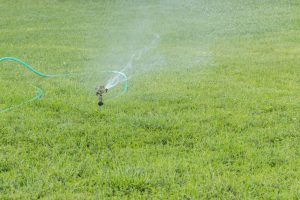
- Water infrequently, deeply, and thoroughly. Most lawns need about 3/4 to 1 inch of water once per week — or once every two weeks when the weather cools. Infrequent but deep watering will encourage deep rooting, making for healthier and hardier plants with a greater tolerance for drought.
- Water at the right time of day. Water early in the day, especially in warmer weather, when evaporation rates are lowest.
- Watch your lawn rather than a calendar. Your lawn needs watering when:
- Grass blades are folded in half
- Grass blades are blue-gray
- Your footprint remains on the lawn
- Water restrictions are in effect — adapt your watering to fit the restrictions.
- Too much water can hurt plants. Over-watering creates shallow roots, making plants more vulnerable to disease and pests, as well as drought.
- Drip or micro-irrigation systems save water. These systems deliver water to the roots of plants, and much less is lost to the atmosphere.
- Mulching. Adding mulch helps keep water in the soil around plants. At least 2 inches is suggested around shrubs, trees, annuals, and vegetable and flower gardens.
- Remove weeds and add native plants. Weeds or other unwanted plants use water. Removing them means more water for the plants you want. Native plants are adapted to our rainy and dry seasons.
- Install a rain sensor. This recognizes when nature brings the water your lawn needs, and it shuts off automatic sprinklers.
- Adjust your lawnmower blades. Most lawns are healthiest when blades are 2 1/2 to 3 1/2 inches long. Longer blades shade the soil and keep in water.
- Keep lawnmower blades sharp. Clean, sharp cuts cause less trauma to grass blades, making the grass more resistant to disease.

![3670104[1]](https://superiorwater.com/wp-content/uploads/2021/03/36701041-150x150.png)
![WQA[1]](https://superiorwater.com/wp-content/uploads/2021/03/WQA1.png)
![bbb-accredited-business-symbol-png-logo-17[1]](https://superiorwater.com/wp-content/uploads/2021/03/bbb-accredited-business-symbol-png-logo-171.png)
![800px-Flag_of_the_United_States[1]](https://superiorwater.com/wp-content/uploads/2021/03/800px-Flag_of_the_United_States1.png)